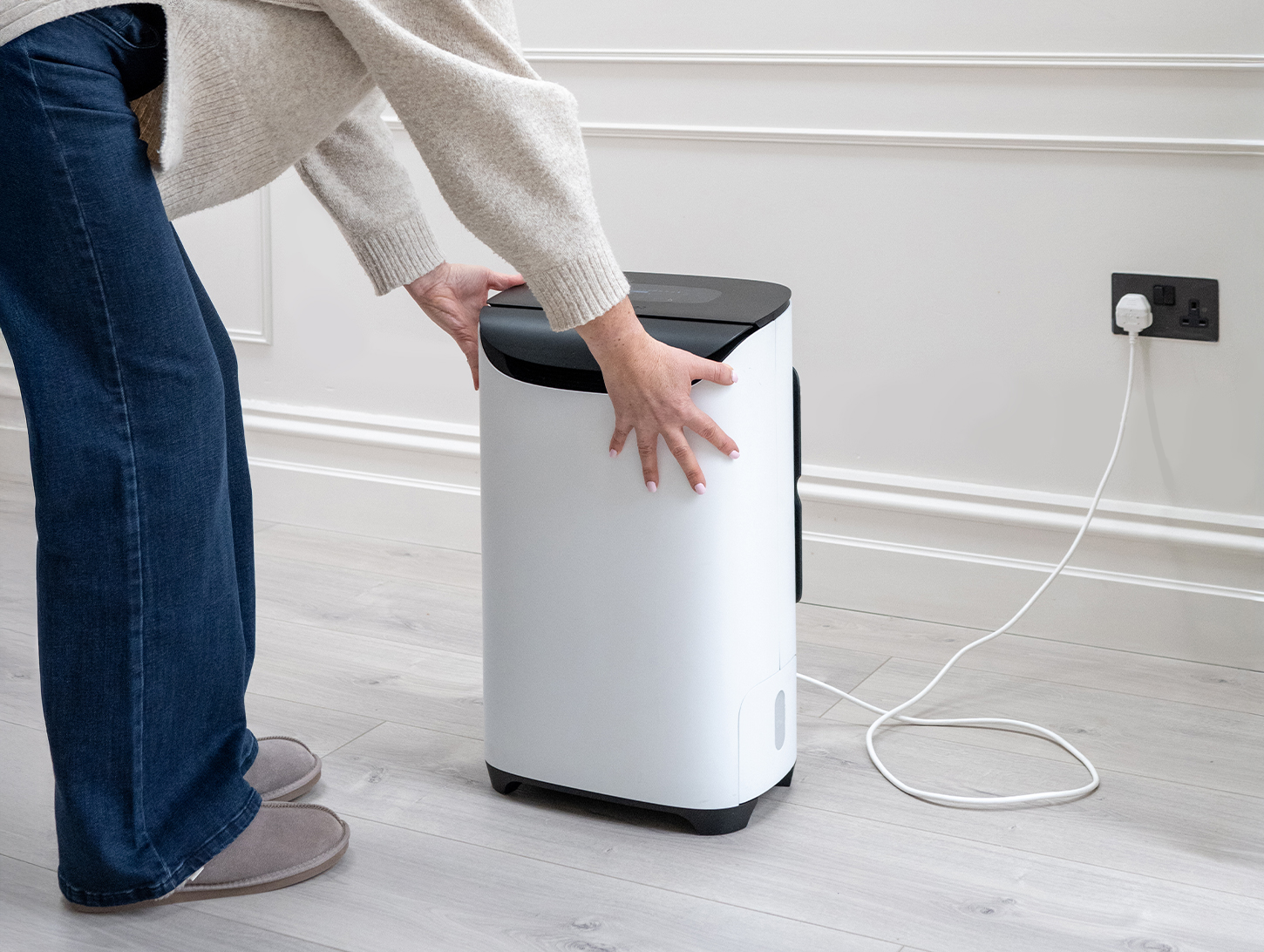The reason why this question comes up is because compressor dehumidifiers extract less water as the temperature and/or relative falls and costs more money per litre of water as the conditions fall.
Desiccant dehumidifiers on the other hand are pretty much consistent and their performance does not change much as temperature falls or rises.
It used to be the standard fall back (probably started by myself to be honest) that a good rule of thumb was to recommend compressor dehumidifiers above 16°C and desiccant dehumidifiers below this point. This was a good guide but advancements in design have clouded this advice.
Compressor or desiccant dehumidifiers?
The dehumidifiers that are creating confusion here are two from the Meaco Platinum Range, the Meaco 20L Low Energy Dehumidifier and the Meaco 25L Low Energy Dehumidryer. Both compressor dehumidifiers extract more water at 15°C than a desiccant dehumidifiers and using around a third of the energy.
At 10°C the Meaco 20L Low Energy extracts between 1.8 and 5.12 litres of water per day which is slightly less than a desiccant but only a little bit less and yet it extracts this water for less than 200 watts.
The 25L model extracts slightly more water using similar energy levels and therefore confuses the agreement further.
Below 10°C below things are more straightforward and the case for desiccant is stronger.
What do you need?
If your application is in the home then the low noise level of the desiccant dehumidifier or the extra heat that they produce might be seen as a positive and might move you towards buying a desiccant. Most cold applications though are outside the home (in a garage, on a boat or in a caravan for example) and in which case all of our desiccants and both of the above models come with auto-restart in case of a power cut.
So when you are looking for a low temperature dehumidifier consider these two compressor models as well and then look at the bigger picture in terms of the extra feature all of the contending models have to offer, for example;

The Meaco DD8L Desiccant dehumidifier is very popular for use in a garage where the temperature will drop over winter.
- The sterlising ioniser on Zambezi or Zambezi’s Daily Run Timer.
- The optional HEPA filters on the 12L and 20L Low Energy dehumidifiers.
- The Laundry drying capabilities of the Dehumidryer.
- The lightweight of the DD8L and DD8L Junior.
- Are you likely to use it in a warmer space in the future?
If you are unsure then the other option is to just call us for a chat on 01483 234900.
Products featured: Meaco DD8L, Meaco DD8L Junior,







32 responses
Hi
We’ve just moved in to a house where the basement is untangled and very damp.
I’ve looked at the Meaco 25L Low Energy Dehumidryer and the DDL8 which looked like the better option given the basement is not heated so will drop below 15deg C but the main issue is I need a pump to drain out of the vent at a height of 1.8 metres
What would you recommend please
Thanks
Duncan,
Meaco Arete 20L or 25L would be best and they are the only dehumidifiers with the option of a built in pump (they will be fine with the temperature as well).
Chris
I like the auto humidity sense every 30 minutes of the DDL8 junior which I have had in my glider trailer for 5 years now.
I want to buy a dehumidifier for the house (4 beds). The main use will be in the bedroom area. Which other models have the auto sense system?
Richard,
Glad you like it, all models have this feature.
Chris
The Zambezi stipulates that it has a minimum operating temperature of 1 degree C at a RH of 40%. That’s quite a low RH – if the RH is higher, will the minimum operating temperature tend to be higher or lower? In practical terms, if my RH is around 60%, do I need to be turning it off at (for example) 2 or 3 degrees C? And what happens if I’ve missed a forecast and the temperature drops too low? Thanks.
Stephen,
In this case the temperature is not dependent on the humidity. The machine will look after itself and you don’t need to do anything.
Chris
MeacoDry Arete or Zambezi for large often cold (6 degrees) ground floor of baronial building?
Thanks
Definitely Zambezi because of the temperature.
We just bought the 20L Meaco with control logic. With the current Brendan storm waging, the outside humidity reads 94% (!). Our house has quite a lot of mould and dampness, and we also have some clothes from washing. We understand all this is making things very tough for the dehumidifier. On top of it, our house is fairly cold and loses heat easily because it is poorly insulated. It is common to have the house at between 13-16C on a relatively cold winter day.
We have set the target to 55%, however, after reducing the humidity for a while it seems now stuck around 70% on average, sometimes dropping slightly below or rising slightly above. Is this normal? And was this the right choice of dehumidified for our conditions, or should we have gone for a dessicant?
How long will it take, on average, until we get to the target humidity?
Andreas,
Thank you for your purchase. You do have to be patient, it will take around six weeks to dry the house out and progress will be steady. Leave it on the setting and let it run 24/7 and you will notice a huge difference over time.
Chris
I need to make use of a dehumidifier in a container where I will have no ability to get 240V.
The solution looks like it will have to be to use an inverter, fed by 12V batteries, and to run the dehumidifier in stints of a maximum of 2-3 hours. There’s a fine balance between choice of dessicant (because it can be used at lower temperatures) and one of the LE compressor models because of the lower energy requirements.
As we’re entering spring now, I’m favouring the LE compressors.
Is either the 20L LE or the 25L LE model suitable for running on an inverter? I’m presuming that a pure sine wave inverter would be needed.
Mike,
I am afraid that we do not know of any successful applications where customers are using an inverter. All of the compressor dehumidifiers need to be able to handle three times running wattage for the startup surge and to our knowledge people have been unable to provide a clean enough power supply to handle this.
If you want to call the office on 001483 234900 to discuss in detail with an engineer then please do.
Chris
Hi Chris
First, thanks for providing this service. I’m such-drunk researching dehumidifiers – I had settled on the DD8l Dessicant till I discovered it only comes with – blue stripe. (why)! Then I thought the plainer Zambezi would be great, lots of nice features, till I read that Ozone can be harmful even at low intake. Now I’m despairing don’t know what to get. 2 bed flat that’s decidedly chilly in winter with general humidity around 70, except for one room (liv rm around 60). Can you please advise?
June,
Thank you for your message. The amount of ozone coming off the Sterilising Ioniser is way below the WHO guidelines but if you don’t want any ozone then you can off course just not turn the ioniser on and then you have all of the benefits of Zambezi (including no blue strip).
On that basis zambezi would be fine for your fat.
Chris
Hi, Ive researched dehumidifiers, and after speaking to both your customer representative and one of your technical staff am unsure whether the Low energy 20litre compressor or the Zambezi DDL desiccant will be better- each recommended a different one. My house is a 5 bed bungalow, but the DH is required principally for 2 beds and a bathroom at the back the house where the rh regularly record 70%+ in the summer and as the temp cools in the evening, then I get the “wet” reading from the hygrometer. I like the potential for less noise from the desiccant, as the rooms are bedrooms (although I suppose I could switch it off at night?) but the small tank is putting me off. I don’t want to be emptying it 2-3 times a day as suggested by your tech guy. There aren’t really any places I can think to place it to facilitate continuous draining. What would you recommend?
Angela,
As you are looking for use in the summer and the winter and noise is an issue I would go for the new MeacoDry ABC 12L as this is now the quietest dehumidifier in our range and will add very little heat to the space in the summer. As you are just concerned with those rooms the capacity will be fine.
Don’t worry about the tank size as you always average out emptying your dehumidifier once a day and it will be fine.
Details can be found here – https://www.meaco.com/dehumidifier/home-dehumidifiers?product_id=95
regards
Chris
Desiccant dehumidifiers comprises two process. One is adsorption & other is regeneration. For regeneration how much capacity of heaters in kw are fitted for regenerating desiccant. Our 2nd query is that what r the quadrant for process and regeneration cycle.
Thank you for your message. the desiccant dehumidifiers have a heater internally that has two settings. In low fan speed it works at circa 330 watts and at high fan speed it works at circa 650 watts.
Hi, I have a shed with power tools and am worried about the moisture over time. It’s insulated and there are no leaks. It is 16ft by 9 ft (interior). As it has no heating it reaches low temperatures.
– I do not wish to empty it regularly, so would like continuous drain.
– I guess I need to leave it on most/all of the time so would like low energy.
– It would be best if it had a timer so I could program it
What is the best option from the Meaco range please?
thanks, Brian
Brian,
I would use the DD8L Zambezi desiccant dehumidifier (does not mind the cold) because it has a Daily Run Timer built in, comes with a hose for continuous drainage and in single fan speed will not use much energy. It also has a more accurate humidity sensor so will turn on and off only as required.
Hope this helps.
regards
Chris